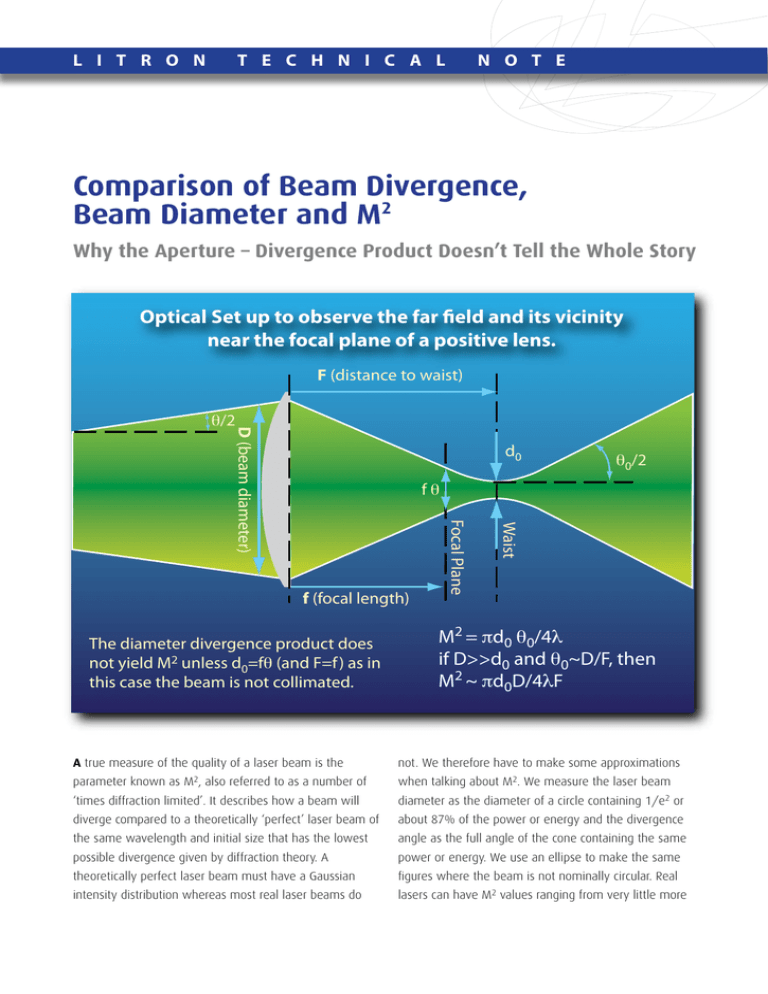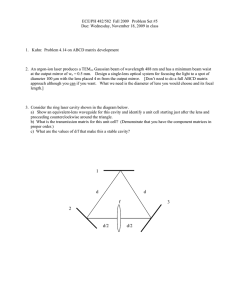Comparison of Beam Divergence, Beam Diameter
advertisement

L I T R O N T E C H N I C A L N O T E Comparison of Beam Divergence, Beam Diameter and M2 Why the Aperture – Divergence Product Doesn’t Tell the Whole Story Optical Set up to observe the far field and its vicinity near the focal plane of a positive lens. F (distance to waist) D (beam diameter) θ/2 d0 fθ A true measure of the quality of a laser beam is the parameter known as also referred to as a number of Waist The diameter divergence product does not yield M2 unless d0=fθ (and F=f ) as in this case the beam is not collimated. Focal Plane f (focal length) M2, θ0/2 M2 = πd0 θ0/4λ if D>>d0 and θ0~D/F, then M2 ~ πd0D/4λF not. We therefore have to make some approximations when talking about M2. We measure the laser beam ‘times diffraction limited’. It describes how a beam will diameter as the diameter of a circle containing 1/e2 or diverge compared to a theoretically ‘perfect’ laser beam of about 87% of the power or energy and the divergence the same wavelength and initial size that has the lowest angle as the full angle of the cone containing the same possible divergence given by diffraction theory. A power or energy. We use an ellipse to make the same theoretically perfect laser beam must have a Gaussian figures where the beam is not nominally circular. Real intensity distribution whereas most real laser beams do lasers can have M2 values ranging from very little more than 1 (the theoretical minimum) to several tens or even the waist must be much greater than its Rayleigh range hundreds. Many practical applications require the lowest from the lens. This value is given by πd02/4λM2. possible value. The optical set up depicted here can be used to measure both the beam divergence and the M2 value of a real laser. Beam Divergence: Irreducible and Reducible In the discussion above, the beam divergence as measured A lens of focal length 1 or 2m is typically used, along with in the focal plane of our lens frequently contains some attenuation optics and the beam is imaged using a CCD reducible elements. These can include sphericity imposed and software. by lensing in an amplifier after the rod (and not fully compensated by the beam expanding telescope) or Measuring the beam in the focal plane of the lens yields sphericity resulting from improper collimation of an the beam’s ‘raw’ divergence, simply by dividing the beam unstable resonator; with a fixed length and a finite diameter in the focal plane by the focal length. Since we number of resonator mirror curvatures, it is often only know for sure what the laser beam diameter is near impossible to achieve perfect collimation. With proper its output aperture, this figure tells us little about the beam beam control after the laser, such as the transmitting optics quality. We do not know the position of the waist of the in a LIDAR system, or the focusing lens in a machining original laser beam or its size. In many real lasers, it can head, this sphericity can be eliminated and the irreducible be located behind the laser (or sometimes well in front of element, as predicted by M2, will determine respectively it) and is thus often smaller than the laser beam diameter the angular resolution of the LIDAR system or the spot size measured at its output aperture. Only the true waist at a work piece. diameter can be combined with the divergence to give M2. In some cases, our waist will be located in the focal plane By looking in the vicinity of the focal plane for a minimum of the lens. Only then can we say that the laser is truly diameter spot, the waist as transformed by the lens, we collimated and only then can the aperture – divergence can gain much more useful information. For real lasers, the product be used to determine the beam quality. In many waist is usually located near the focal plane and usually a practical cases, this does not hold true. little way after it. Note that the original beam divergence is eliminated in the expression that gives M2. It is expressed The irreducible divergence (full angle) is given by the in terms of the beam diameter at the waist, the diameter expression 4M2λ/πd where d is the diameter of the laser of the beam at the lens and the distance of the waist from beam measured at its waist. For reasons given above, the lens. All these parameters are relatively easily this figure is often lower than the ‘raw’ divergence of the measured. The focal length of the lens and the beam laser beam itself. To a first order approximation, the above diameter at the lens need to be chosen such that the waist expression holds true even if the laser beam is expanded is much smaller than the beam diameter at the lens. or reduced by telescopes and the like. Technically speaking, to achieve accurate measurements, L it ro n L a s e rs Ltd 8 Co n s u l Ro a d , R u g by, Wa r w i c ksh i re CV 2 1 1 PB En g l a n d Te l + 4 4 (0 )1 7 8 8 5 7 4 4 4 4 Fax + 4 4 (0 )1 7 8 8 5 7 4 8 8 8 Litro n Lasers No rth Am eri ca 24 49 A r n i c a D r i v e , B o ze m a n , M T 59715 U S A T +1 (4 0 6) 5 2 2 7 5 6 6 F +1 (4 0 6) 5 2 2 7 5 67 w w w . l i t r o n l a s e r s . c o m PB0115:1 For more information contact: Litron Lasers Email: sales@litronlasers.com



